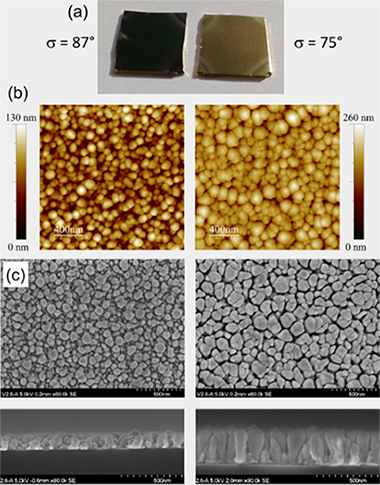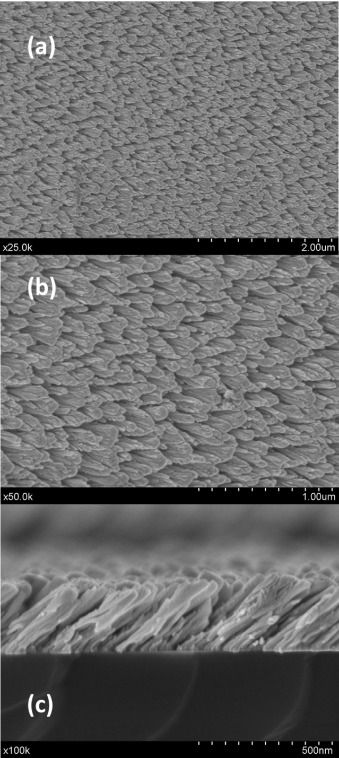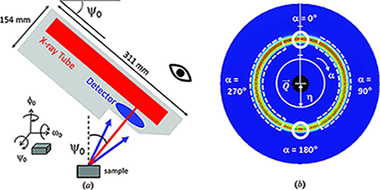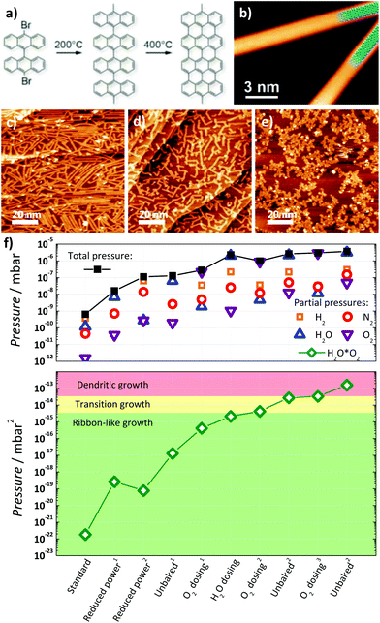Artículos SCI
2017
2017
Nanotecnología en Superficies y Plasma
Fabrication of black-gold coatings by glancing angle deposition with sputtering
Vitrey, A; Alvarez, R; Palmero, A; Gonzalez, MU; Garcia-Martin, JMBeilstein Journal of Nanotechnology, 8 (2017) 434–439
Show abstract ▽

The fabrication of black-gold coatings using sputtering is reported here. Glancing angle deposition with a rotating substrate is needed to obtain vertical nanostructures. Enhanced light absorption is obtained in the samples prepared in the ballistic regime with high tilt angles. Under these conditions the diameter distribution of the nanostructures is centered at about 60 nm and the standard deviation is large enough to obtain black-metal behavior in the visible range.
Febrero, 2017 | DOI: 10.3762/bjnano.8.46
Nanotecnología en Superficies y Plasma
Cholesterol biosensing with a polydopamine-modified nanostructured platinum electrode prepared by oblique angle physical vacuum deposition
Martin, M; Salazar, P; Alvarez, R; Palmero, A; Lopez-Santos, C; Gonzalez-Mora, JL; Gonzalez-Elipe, ARSensors and Actuators B-Chemical, 240 (2017) 37-45
Show abstract ▽

This paper reports a novel cholesterol biosensor based on nanostructured platinum (Pt) thin films prepared by Magnetron Sputtering (MS) in an oblique angle (OAD) configuration. Pt thin films were deposited onto a gold screen-printed electrode and characterized using Rutherford Back Scattering (RBS), Scanning Electron Microscopy (SEM), X-ray Diffraction (XRD), Cyclic Voltammetry (CV), X-ray Photo-electron Spectroscopy (XPS), Atomic Force Microscopy (AFM) and wetting analysis. Our results confirmed that the film is highly porous and formed by tilted nanocolumns, with an inclination of around 40 degrees and a total thickness of 280 nm. XRD and CV analysis confirmed the polycrystalline nature of the Pt thin film. Cholesterol oxidase (ChOx) was covalently immobilized using a bioinspired polymer, polydopamine (PDA), via Schiff base formation and Michael-type addition. After being immobilized, ChOx displayed apparent activation energy of 34.09 kJ mol(-1) and Michaelis constant (K-M) values of 34.09 kJ mol(-1) and 3.65 mM, respectively, confirming the high affinity between ChOx and cholesterol and the excellent ability of the PDA film for immobilizing biological material without degradation. Under optimized working conditions the developed biosensor presented a sensitivity of 14.3 mA M(-1)cm(-2) (R-2:0.999) with a linear range up to 0.5 mM and a limit of detection of 10.5 mu M (S/N= 3). Furthermore, the biosensor exhibited a fast response (<8 s), good anti-interference properties and high stability after relatively long-term storage (2 months).
Febrero, 2017 | DOI: 10.1016/j.snb.2016.08.092
Materiales de Diseño para la Energía y Medioambiente
Precision and accuracy of stress measurement with a portable X-ray machine using an area detector
Lee, SY; Ling, JJ; Wang, SH; Ramirez-Rico, JJournal of Applied Crystallography, 50 (2017) 131-144
Show abstract ▽

The use of portable X-ray stress analyzers, which utilize an area detector along with the newly adopted 'cos alpha' or full-ring fitting method, has recently attracted increasing interest. In laboratory conditions, these measurements are fast, convenient and precise because they employ a single-exposure technique that does not require sample rotation. In addition, the effects of grain size and orientation can be evaluated from the Debye ring recorded on the area detector prior to data analysis. The accuracy of the measured stress, however, has been questioned because in most cases just a single reflection is analyzed and the sample-to-detector distances are relatively short. This article presents a comprehensive analysis of the uncertainty associated with a state-of-the-art commercial portable X-ray device. Annealed ferrite reference powders were used to quantify the instrument precision, and the accuracy of the stress measurement was tested by in situ tensile loading on 1018 carbon steel and 6061 aluminium alloy bar samples. The results show that the precision and accuracy are sensitive to the instrument (or sample) tilt angle (0) as well as to the selected hkl reflection of the sample. The instrument, sample and data analysis methods all affect the overall uncertainty, and each contribution is described for this specific portable X-ray system. Finally, on the basis of the conclusions reached, desirable measurement/analysis protocols for accurate stress assessments are also presented.
Febrero, 2017 | DOI: 10.1107/S1600576716018914
Materiales de Diseño para la Energía y Medioambiente
Packaging Materials: All‐Natural Sustainable Packaging Materials Inspired by Plant Cuticles (Adv. Sustainable Syst. 1‐2/2017)
Heredia-Guerrero, JA; Benitez, JJ; Cataldi, P; Paul, UC; Contardi, M; Cingolani, R; Bayer, IS; Heredia, A; Athanassiou, AAdvanced Sustainable Systems, 1 (2017)
Show abstract ▽
In article number 1600024, José A. Heredia‐Guerrero, Athanassia Athanassiou, and co‐workers present new, sustainable composite materials inspired by plant cuticles. These materials are fabricated by the impregnation of fibrous cellulose substrates with a naturally occurring polyhydroxylated fatty acid, and subsequent polymerization of the latter into a polyester. In the image a piece of this new material is shown together with tomato and pepper fruits. Cover image created by Dr. Duilio Farina.
Febrero, 2017 | DOI: 10.1002/adsu.201770012
Nanotecnología en Superficies y Plasma
High vacuum synthesis and ambient stability of bottom-up graphene nanoribbons
Fairbrother, A; Sanchez-Valencia, JR; Lauber, B; Shorubalko, I; Ruffieux, P; Hintermann, T; Fasel, RNanoscale, 9 (2017) 2785-2792
Show abstract ▽

Carbon-based nanomaterials such as graphene are at a crucial point in application development, and their promising potential, which has been demonstrated at the laboratory scale, must be translated to an industrial setting for commercialization. Graphene nanoribbons in particular overcome one limitation of graphene in some electronic applications because they exhibit a sizeable bandgap. However, synthesis of bottom-up graphene nanoribbons is most commonly performed under ultra-high vacuum conditions, which are costly and difficult to maintain in a manufacturing environment. Additionally, little is known about the stability of graphene nanoribbons under ambient conditions or during transfer to technologically relevant substrates and subsequent device processing. This work addresses some of these challenges, first by synthesizing bottom-up graphene nanoribbons under easily obtained high vacuum conditions and identifying water and oxygen as the residual gases responsible for interfering with proper coupling during the polymerization step. And second, by using Raman spectroscopy to probe the stability of nanoribbons during storage under ambient conditions, after transfer to arbitrary substrates, and after fabrication of field-effect transistor devices, which shows structurally intact nanoribbons even several months after synthesis. These findings demonstrate the potential of graphene nanoribbon technologies by addressing some limitations which might arise in their commercialization.
Febrero, 2017 | DOI: 10.1039/C6NR08975E
- ‹ anterior
- 200 of 420
- siguiente ›














